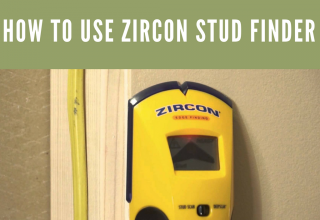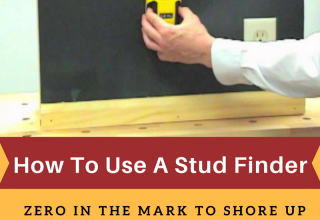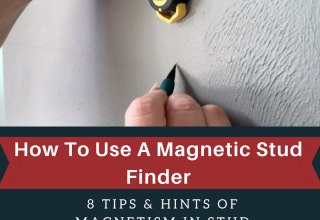
Beefing up your hardware kit with an up-and-running stud finder makes the task of locating a framing scantling in the wall a piece of cake. The best stud finder on the market will hone in the center or edge of a stud, pipes, joists, and live AC wiring.
Studs offer a sturdy, supportive structure for framing drywall or mounting pictures, TVs and other items. A wall supportive structure nailed directly to a stud guarantee a secure reinforcement of the things or objects mounted. Stud finders take your toolbox a notch up higher.
Stud sensors at the top of the heap stay ahead of the curve with high-precision scanning, battery lifespan, dual-tool with leveling laser, bright LCD and audiovisual alerts.
Things To Consider about Best Stud Finder On The Market
1. Neodymium-Driven Magnetic Stud Finder
Top-class magnetic stud finders offer an ultra-efficient and intuitive hands-on tool to detect nails or screws fixing the drywall to studs. Benefits include durability, budget-friendliness, and functionality.
Dual neodymium magnets can probe a sprawling area to save time and efforts. Neodymium magnetism forces help you pinpoint the metallic framing stud beneath thicker, dense plasterboards or lath.
Notched and multi-functional design models help you nail down studs’ position by highlighting.
Moving neodymium can detect screws or nails through all manner of surfaces. It runs at a pace relative to the depth of the stud making it ideal for drywall and plaster walls.
Do not require calibration, batteries, LED or electromechanical making them hassle-free but down-to-earth. Some versions detect a framing stud like whacking of two magnets.
2. Scanning Capabilities of Electronic Stud Sensors
Top-notch electronic models rapidly and seamlessly hone in the edges of metal or wooden studs and joists buried beneath walls, ceilings or floors.
Multi-scanner electronic stud finders can detect a variety of embedded materials including plastic, wood, metal, studs, conduit, unsheathed AC electrical wiring, and joists located beneath walls, floors, and ceilings.
They can scan through multiple wall surface seams from drywall, ceramic tile, concrete, plywood, and plaster.
Internal capacitive plates alter the electromagnetic parts of the wall and change in density to hit a stud. You can narrow down the edge of a framing stud, center and instant location of different parts of the target.
3. Pinpoint-Accuracy
Electronic multi-function stud sensors can detect timber or metal studs, as well as AC, live electrical wiring with scalpel-like precision.
- Wire-warning sensors will indicate the existence of live, unsheathed electrical wiring at a predetermined depth such as 2”.
- Stud scanning modes identify the edges of wood and metal studs up to ½” to ¾” or even deeper.
- Deep-Scan modes pinpoint ferrous metal like rebar and non-ferrous copper pipes
- Auto-correcting technology automatically rectifies typical user errors, like when scanning begins above a stud. Pinpointing systems mark the bull’s eye and hit the spot.
- Stud sensors emit an electrical field to detect fluctuations as it probes a surface to find wood framing buried to ¾” and record-setting depth capacity to find rebar, pipe, steel framing and conduit in wall crevices and concrete.
4. Construction & Design
- The cone-shaped crevice in the device’s center allows you to insert a pencil to mark and level a stud’s edge. Others have a recessed surface shaped to host a laser level that you project along a framing.
- Most electronic stud finders come with an ergonomic non-slippery grip for comfortable use and control of the device.
- The straightforward and pinpoint electronic stud finder provides an intuitive interface and minimalist design.
- Subtle body design held comfortably in your hand at all angles will diminish common scanning errors.
- Robust construction for tough demands and ravages of the construction site offers improved durability, reliability and quality.
5. Audiovisual Alerts for Easier Navigation
- They emit a beeping signal or LED flashlight when they detect a stud beneath the device.
- Visual LED and audible alerts help you zero in a stud’s location, edge, and center. “Over-the-stud” alerts caution if you start scanning over a target.
- Easy-to-spot bars on LCD screen will indicate the edge of a stud in various scanning modes.
- LCD screens illuminated graphical indication may also include battery level
- Nonstop beeping will alert you to a calibration error to repeat the process.
- Intelligent backlit LCD or screen glows backlight for a clear view even in low-light ambiances, which shows detection mode, center-finding, and other readings.
6. Auto-Capability for Convenient Use
- Auto-calibrated stud detectors adapt to inconsistencies in wall structures for maximum reliability when scanning.
- Automatic calibration prevents machine errors. Pre-determined settings render automatic output.
- Auto-leveling technology like laser levels projects small horizontal lines so you can carve your marks accurately.
- Auto-power off when it becomes inactive for 60 seconds or so saves energy for a long-lasting grid.
- Automatic-adjusting or self-leveling systems help minimize scanning errors.
7. Ultrasound Detectors At the Frontline
Stud finders powered by ultrasound technology offers a hypersensitive system to pick any discrepancies in wall density or dialectic constant accurately.
They not only home in the stud but they also estimate its width shedding light on the exact spot to drive in the screws or nails.
The edge finder senses the fluctuations in wall density to indicate the featheredge of framing studs. Center-finding sensors have multiple detectors to prod the various variations in the electromagnetic flux. It shows you the midpoint of a stud in the wall. Instant finders with multi-sensor plates pinpoint the center and locate a variety of studs in a single stroke.
8. All Bells and Whistles
Top-end stud sensors offer additional features for the seamless operation to instantly pinpoint the stud’s location, center, and edges simultaneously.
- Built-in level, ruler, and other multi-functional tools make tasks such as measurement easy duck soup.
- Arrays of LED lights allow you to view the accurate location of the objects and dimensions beneath the surface of the walls.
- Unique spotlight pinpointing system and audio signals notify you when you hit a stud.
- Future stud locators synchronize with apps to render a better reading about targets inside the walls.
- Built-in erasable surface markers and subtle design for an ergonomic grip, as well as highlighting clues, improve navigation.
Final Verdict
You can cherry-pick the best stud finder on the market by considering the features and technology integrated into the devices. Smash hits can pick out and distinguish magnetic from non-magnetic materials, live AC wiring and a variety of targets.
LCD digital displays, LEDs, and audio sounds combined in these units help you hone in the center, edge or hosting region of studs with clockwork accuracy. Smart technology supports deep scanning, detection of a variety of targets such as electrical wires, pipes, studs, and rebar as well as hard-to-scan materials like ceramic tiles.
With advanced inventions including micropower impulse radar coming down the pike, more extensive ranges and multi-functional units will flood the market.

















Leave a Reply